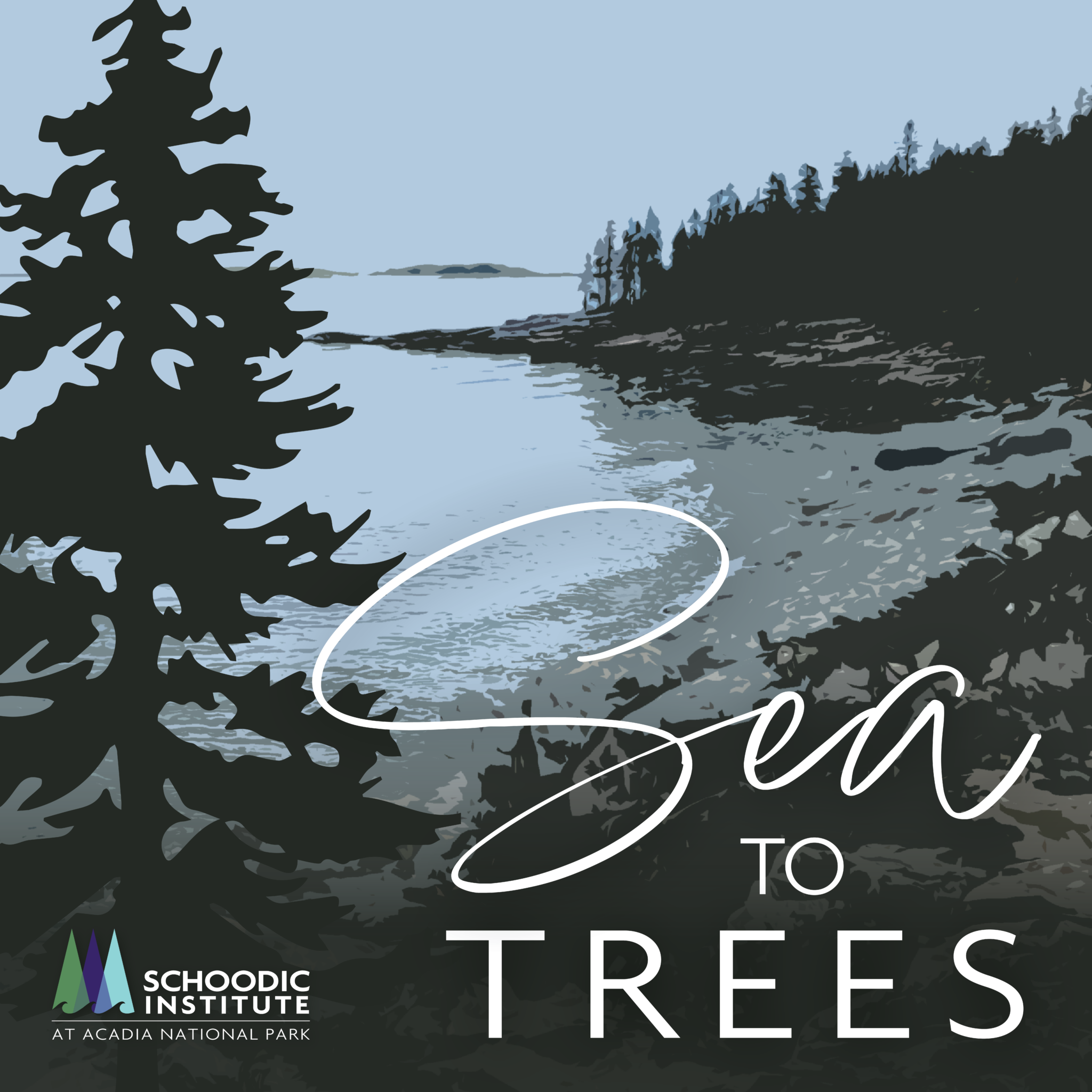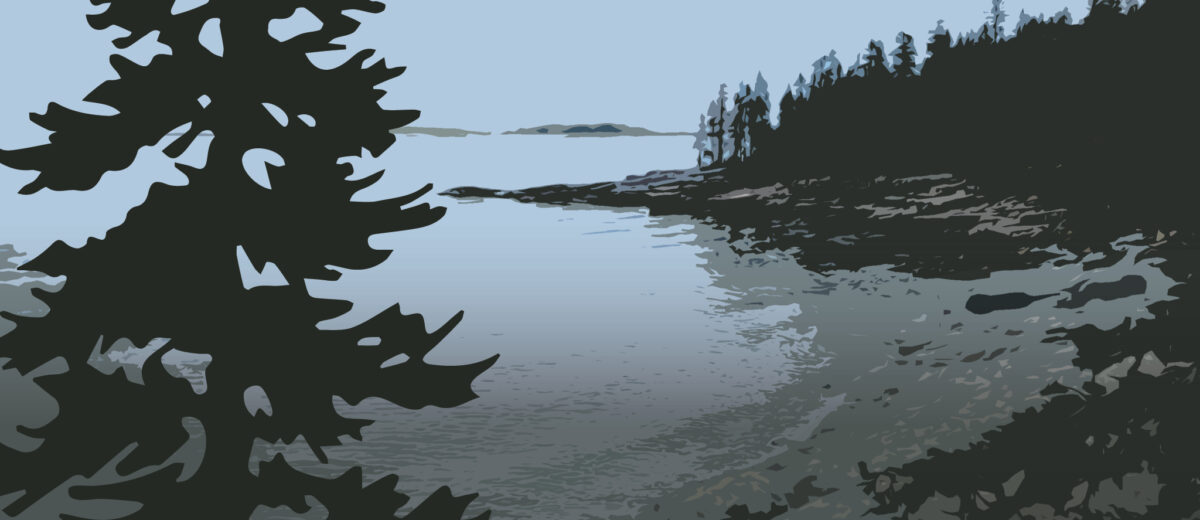Our season 3 premiere is available now!
Sea to Trees is a podcast that tells the stories of the science happening in and around Acadia, from the rocky shoreline to the evergreen forests to the granite mountaintops.
This podcast is possible with generous support through The Cathy and Jim Gero Acadia Early-Career Fellowship, a partnership among Schoodic Institute, National Park Foundation, and National Park Service.
Sea to Trees is a podcast from Schoodic Institute at Acadia National Park. Acadia National Park is on traditional lands of the Wabanaki, People of the Dawn. As a nonprofit partner of the National Park Service, Schoodic Institute inspires science, learning, and community for a changing world.
LISTEN NOW

Since Acadia National Park’s inception over 100 years ago, research has played a large part in its story. In season three of Sea to Trees we’re learning about research that delves into the past, seeks to understand the present, and charts the future of Acadia. We’ll walk through the same spruce forests as MacArthur’s warblers, try to understand how human activity is affecting some of the smallest creatures in the park, and illustrate the power of sea level rise with a group of young scientists. What can we learn from the past and present to help our future?
Season three is hosted by Trevor Grandin, 2024 Cathy and Jim Gero Acadia Early-Career Fellow in Science Communication.
Episode 1: Past, Present, and Future | Historical Aerial Photography. Tucked away on the University of Maine campus is a treasury of film that chronicles New England’s landscape from 1946 to 2015. We’ll hear from the researcher who is digitizing thousands of aerial photographs and making them accessible online. What can these photos tell us about the history of Acadia and how can they influence the future of land stewardship? Find out on the season three premiere of Sea to Trees.
The second season of the show seeks to answer the question, “What does it mean to conserve in the face of climate change?”
Season two was made by Catherine Devine, 2023 Cathy and Jim Gero Acadia Early-Career Fellow in Science Communication. Catherine Schmitt is our senior editor. Additional production support in season two was provided by Catherine Wang. Our music was written by Eric Green, performed with Ryan Curless and Stu Mahan and recorded at North Blood Studios in Damariscotta, Maine. The cover art was created by Sarah Luchini.
Episode 1: Restoration | The Great Summit. From social trails to heavy rain events, the summits in Acadia National Park are experiencing a lot of degradation. In this episode, we’ll discover how a backpack full of dirt can help bring life back to Acadia’s mountains.
Episode 2: Restoration | Wild Bird Chase (part 1). In this episode, we learn all about the birds in Acadia, their songs, and what we can do to keep them around.
Episode 3: Restoration | Wild Bird Chase (part 2). This episode begins with naturalist Laura Sebastianelli, who has dedicated her summers to recording all the bird songs in Acadia National Park. We follow Laura on her chase to record the American Bittern, learn why it’s so important to record Acadia’s birdsongs, and talk to all sorts of ornithological experts along the way.
 In the first season of the show, we explore the ever-growing field of citizen science – the participation of non-scientists in research at any level – and how it can help answer questions about our changing world.
In the first season of the show, we explore the ever-growing field of citizen science – the participation of non-scientists in research at any level – and how it can help answer questions about our changing world.
This show was created by Olivia Milloway, 2022 Cathy and Jim Gero Acadia Early-Career Fellow in Science Communication. Catherine Schmitt is our senior editor. Additional editorial and production support in season one was provided by Mikayla Gullace, Maya Pelletier, and Patrick Kark. Our music was written by Eric Green, performed with Ryan Curless and Stu Mahan and recorded at North Blood Studios in Damariscotta, Maine. The cover art was created by Sarah Luchini. Laura Sebastenelli of Schoodic Notes recorded the soundscape at Bass Harbor Head Light Station heard at the beginning of each episode in season one.
Episode 1: Citizen Science | The Dragonfly Mercury Project. We discuss the nation’s largest assessment of mercury contamination and risk. The project, which started between scientists, teachers, and students at Acadia National Park, now relies on volunteer citizen scientists who collect dragonfly larvae. How has the help of more than 6,000 citizen scientists improved our understanding of mercury pollution across the US? To answer this question, we spoke with Abe Miller-Rushing from the National Park Service, Hannah Webber from Schoodic Institute, and Sarah Nelson from the Appalachian Mountain Club.
Episode 2: Citizen Science | Landscape of Change. We travel back to the 1880s when a group of Harvard students called the Champlain Society completed the first natural history survey on the land that would become Acadia National Park. While the Champlain Society used guns to collect birds, nowadays citizen scientists can use cameras to capture photographs instead, uploading the images to an online user-sourced global database of biodiversity called iNaturalist. If the Champlain Society were around today, would they use iNaturalist? We talked with Catherine Schmitt and Kyle Lima of Schoodic Institute to learn more about Landscape of Change, a project comparing what the Champlain Society documented to what modern-day citizen scientists find. We also talked with Carrie Seltzer, who works at iNaturalist, about how the app can help connect people with the world around them. And, we put iNaturalist to the test in the field with citizen scientists.
Episode 3: Citizen Science | Project ASCO. Maya Pelletier, the Cathy and Jim Gero Acadia Early-Career Fellow in Science Research, calls rockweed (a type of seaweed) “the van Gogh of the intertidal.” When the tide is low, the algae drapes across the rocks in the intertidal zone and creates green-brown contours that look like the artist’s famous brush strokes. Though rockweed is a harvested marine resource, there’s no coast-wide estimate of the state of rockweed on Maine’s coast. Could a citizen science project called Project ASCO help paint a picture of Maine’s rockweed? We talk with Hannah Webber, Marine Ecology Director at Schoodic Institute, along with Ari Leach, a biologist at the Maine Department of Marine Resources. We squelch through the seaweed with citizen science volunteers, weighing, measuring, and counting rockweed.


